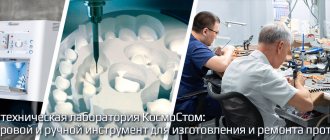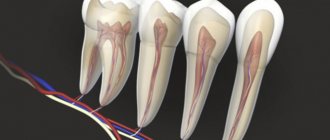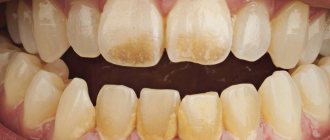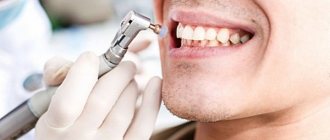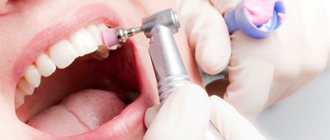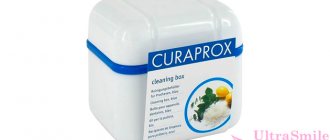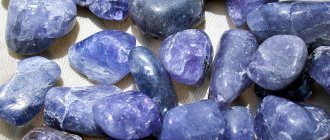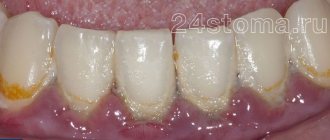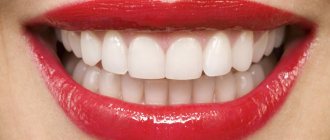Tartar removal
Most of us rarely visit the dentist, believing that tartar is an aesthetic problem and can be easily gotten rid of by routine teeth cleaning. Unfortunately, it is impossible to remove hardened plaque on your own without the participation of a specialist. A person rarely devotes much time to oral hygiene; as a result, the resulting plaque turns into tartar, which is impossible to get rid of without the help of professionals.
If you don’t know how to remove tartar , read this article carefully, or even better, make an appointment with your dentist for the nearest date.
It's all due to poor hygiene
Hard plaque is a special mineralized film that consists of many microbes. Poor daily brushing leads to their proliferation and promotes the growth of a soft, invisible film on the teeth. It, under the influence of microflora, begins to actively mineralize within fifteen hours.
Mineralization is completed after 7 days, and after 6 months full-fledged stones appear on the bone formations. The outer protective shell of the coronal part of the tooth, which is overgrown with plaque, begins to darken, but this is not the only negative aspect: hardened plaque (dental deposits) is the main infectious center and becomes the basis for the appearance of a number of diseases, which cause many troubles, including tooth loss.
Thus, cleaning hardened plaque is not only a hygienic aspect. This procedure can be called tooth-preserving, and competent treatment at the dentist is rarely complete without it. Before: replacing a lost or irreversibly damaged tooth with an artificial implant; installation of orthodontic braces; whitening or other procedures, the specialist carefully removes the stones so that the procedure leads to a positive result.
Tartar
Dangers of tartar on teeth
If the layers are not treated in a timely manner, you may encounter a whole range of complications. Some of them can even lead to the loss of your own teeth if the symptoms are not dealt with in time.
The deposit on the teeth can be colored in different shades by natural dyes such as coffee, wine, tea, cigarette smoke, etc. But discoloration is not the whole problem; the appearance of bad breath also creates many problems due to the development of microflora.
It doesn’t matter how dense the deposit on the teeth is, but microorganisms and bacteria develop in it, which cause the development of inflammation, and as a result, damage to the gums. The sharp edges of the stone injure the gums and cause bleeding of the gums, loosening of teeth and their loss. Today it has been proven that plaque is a very strong factor contributing to the appearance of gingivitis and various other inflammatory diseases. Therefore, removing tartar from teeth can become one of the main preventive measures against various types of gum pathologies.
Caries
In the absence of treatment of the deposits, a person often faces caries. Its cause is streptococci, which soften tooth enamel. Caries is a constant source of infection in the body. It also destroys teeth.
Periodontal disease
With periodontal disease, the necks of the teeth are gradually exposed due to the influence of pathogenic microflora. This disease is fraught with early tooth loss.
Gingivitis
Gingivitis is a disease accompanied by inflammatory processes in the gum tissue. Pathology quickly leads to loosening and loss of teeth.
Periodontitis
A disease accompanied by inflammation of the tissue surrounding the tooth is called periodontitis. If treatment is not carried out on time, there will be complaints of bleeding gums and bad breath. In especially advanced cases, teeth will fall out completely.
What types of formations are there?
Is it possible to remove tartar ? It all depends on its type. Hardened dental plaque contains organic and inorganic components. About thirty percent of the components are organic: microorganisms, protein, etc., and inorganic components include calcium salt.
Hard plaque is classified according to where it accumulates. Separate the stones:
- Above the gums. They can be noticed when smiling; the shade of such plaque is dark or yellow. Removed quickly.
- Under the gums. They form under the gum and are therefore difficult to notice with the naked eye. The tooth looks completely healthy.
As a rule, such formations can be seen if you look at the gums - hard plaque makes them turn blue, swelling and bleeding appear. Stone in the space between the gum and tooth root can cause minor local suppuration.
Noticeable hardening signals a lack of hygiene, and subgingival formations are associated with a disruption of the connection between bone formation and gums, which destroys all tissues. Formations under the gum can only be detected by a dentist using special instruments. Finding them and removing them is a very difficult task, which not every specialist can handle.
If you are wondering how much it costs to remove tartar , then the price depends on its type and the complexity of the procedure. The minimum price in the CIS is 20-30 dollars.
How to remove plaque from the inside of teeth?
Deposits on the inner surface are formed as a result of the accumulation of food debris and harmful bacteria, which multiply intensively, destroying the enamel as a result of their vital activity. If cleansing procedures are not carried out in a timely manner, the process spreads to the gums and bone structures of the jaw, leading to severe pathologies and premature tooth loss.
How to remove plaque from the inside of teeth? It is important to use an electric toothbrush regularly, brushing your mouth at a 45-degree angle. You can enhance the healing effect of the paste using special ultrasonic brushes.
As traditional methods, you can consider the method of cleansing the oral cavity using crushed activated carbon, a mixture of baking soda and 3% hydrogen peroxide. But this method is absolutely not suitable for weakened enamel.
Why does it appear?
The main cause of any problem is insufficient hygiene. If you regularly cleaned your mouth poorly, did it with the wrong brush, or used a low-quality paste, then expect the formation of not only hardened plaque, but also destruction of hard tooth tissue, and other equally dangerous diseases. To avoid adverse effects, choose the right brush and toothpaste, also follow the correct technique for brushing your teeth and be sure to rinse and floss your mouth after eating.
The accelerated appearance of hardened plaque causes:
- Hobbies for confectionery, carbonated drinks, foods rich in simple carbohydrates;
- Frequent consumption of soft or liquid foods, food fillers and flavored sweeteners;
- Poor diet;
- Drinking alcoholic beverages and smoking;
- Heavy secretion of saliva;
- Taking a number of pharmacological drugs;
- Chronic inflammatory diseases.
How to remove stone in dentistry
The best way to combat plaque and deposits is professional cleaning. Today, as part of this procedure, dental clinics offer various techniques. Let's look at them in a little more detail:
- Air Flow sandblasting is a popular technique that is based on cleaning using a water-salt solution. It is supplied under high pressure and allows you to remove hardened deposits in hard-to-reach places. The smallest particles of the mixture literally beat off plaque and pigments from the enamel surface. For some time after the procedure, teeth may remain sensitive, especially to temperature changes in food and drinks. After cleansing, it is better to limit the consumption of coloring products, coffee, tea and smoking,
The photo shows the method of brushing teeth with the Air Flow system. - ultrasonic cleaning – under the influence of an ultrasonic scaler, the stone literally breaks down, turning into powder. Thanks to the simultaneous supply of water, the remaining plaque and hard deposits are easily and quickly washed away from the surface of the teeth. The technology allows for effective cleaning of gum pockets. The procedure is often performed in combination with Air Flow and is absolutely painless for the patient. After cleaning, the enamel is polished and coated with a fluorine-containing compound to further strengthen hard tissues,
Using the Vector ultrasound device, a specialist cleans periodontal pockets
“I am a regular client of your clinic, and I decided to express my gratitude with this review. I have treated your caries several times and for several years now I have been having my teeth cleaned here with Air Flow, at least once every six months. I really like the quality of service, the work of the staff and the atmosphere in general. Thanks to the efforts of your specialists, the procedure is always quick and absolutely painless. Your smile becomes snow-white, and no whitening is necessary! Personally, for me the effect lasts all these six months, until the next cleaning. True, I don’t smoke or drink coffee, I try to take care of my health...”
Marina A.K., Moscow, fragment of a review on the website of a dental clinic
- dry cleaning – special chemical reagents are also used to effectively break down hardened contaminants. Their help is resorted to in cases where ultrasound and sandblasting are ineffective. Hydrogen peroxide and compositions with abrasive particles are used as preparations.
The photo shows chemical teeth cleaning - Hand Cleaning – Hand tools can also be used to remove pigmented areas. These are small thin hooks with which the specialist “catches” the accumulations under the gums and carefully removes them from the pockets.
The manual method uses hooks for cleaning.
Gradually, hardened deposits will begin to destroy hard tissue, which can easily lead to caries. The microabrasion procedure will help stop this process. The essence of the technology is gentle polishing of the enamel surface, which carefully removes pigmented spots and prevents further development of the pathological process.
As part of the procedure, the specialist removes a very thin layer using a special abrasive composition. The layer thickness usually does not exceed 25-70 microns, so there is no need to worry about thinning of the enamel and its increased sensitivity. In complex clinical cases, up to 200 µm is sometimes removed1. The procedure is relevant for patients who have heavily contaminated and pigmented areas when they do not respond to the above cleansing methods. Indications for its treatment also include a spotted form of hypoplasia, caries at the “white spot” stage and signs of demineralization.
What is tartar?
The process of the appearance of hardened deposits begins with the formation of a slight plaque, then mineral salts accumulate on it, forming crystallization axes, and as a result, an increase in crystals contributes to the deposition of plaque, which, over time, becomes like stone.
Hardened plaque consists of 90% dangerous microbes, the proliferation of which can cause:
- Gradual destruction of hard tooth tissues.
- Unpleasant smell.
- Diseases of the oral mucosa.
- Worsening of a number of chronic diseases of the oral cavity.
- Inflammation of the mucous membrane of the gums.
- Spread of the inflammatory process to other tissues of the jaw or gums. If cleaning is not done immediately after plaque has accumulated under the gums, germs can attack the roots, leading to bone loss.
Important. By remembering this combination of words “ tartar removal dentistry ”, you will never have dental problems.
Tartar removal
Reasons for failure
I repeat once again that only your doctor can help you completely get rid of tartar. Folk remedies, home conditions, dances that make rain, and cargo cult - all this, at best, is only prevention and disinfection of the oral cavity, but not complete disposal of tartar. The problem can be masked, but know that an infection is brewing under your gums, threatening the integrity of your teeth. In the long term, these are big expenses and painful operations. Therefore, it is better to spend money now and have your teeth professionally cleaned.
Untimely or irresponsible treatment is the main reason for failure. An advanced case takes longer and is more difficult to treat than the initial stage, which is not noticed in time or is ignored.
Tartar – removal
Is it necessary to remove tartar ? The answer is clear - yes!
Minor daily plaque can be easily removed through natural hygiene. The remaining dental deposits can only be removed by a dentist using special pharmacological agents. Since the last stage of hardening occurs over 6 months, you need to make an appointment with a doctor twice every 12 months so that he can monitor the condition of your teeth and gums and, if necessary, remove the stone, protecting your teeth and gums from an insoluble problem.
Remove tartar in the clinic
There are a number of professional methods for cleaning solid deposits - the basis for their choice is the amount of work and the capabilities of the dental clinic.
Choosing a method
Deposits on teeth can only be removed in a dental clinic using modern techniques, such as ultrasound, powder jet, instrumental, etc.
Ultrasound method
Ultrasonic cleaning uses a so-called scaler, the tip of which creates oscillatory movements with a frequency of 25-30 thousand Hz. Thanks to this, all deposits, both hard and soft, are removed.
Air-Flow method
With the Airflow powder blasting technique, soft deposits disappear instantly. The essence of this technique is to supply a strong aerosol jet through a special thin tube. It consists of air, water and a cleaning powder that knocks down all deposits from the most remote corners and gum pockets, up to 10mm deep.
Dry cleaning
Chemical treatment of deposits is based on the use of a special composition that easily softens deposits and allows them to be removed from teeth without difficulty. The procedure has many disadvantages (for example, the likelihood of damaging enamel or soft tissue, an unpleasant taste in the mouth, the inability to cope with hard deposits), which is why it is used less and less in practice.
Mechanical cleaning
The instrumental method - curettage, is used in cases of stone deposits in the gum pockets and under the gums, when other methods are ineffective. In this case, not only deposits are removed, but also pathologically altered gum tissue.
Laser Application
Laser technology in the treatment of dental plaque has proven itself to be effective and safe. In this case, the deposit is removed layer by layer, a painless method. The disadvantage is the high price, but the treatment is suitable even if children need help.
Methods for removing tartar
Removal according to the “classic”
For many years, plaque deposits were cleaned using hand tools. For this purpose, hooks and hammers were used: the hardening particles were beaten off from the bone formations, particle by particle, and then cleaned. This technique was very uncomfortable for the patient and was accompanied by a sensitive outer protective shell of the tooth and damage to the soft tissue. In recent years, safe and effective ways to combat plaque have been explored, so today mechanical cleaning is considered a relic of the past.
Ultrasound removal of tartar
Dental care
The presence of tartar leads to diseases of the gums and teeth. These are periodontitis and periodontal disease, gingivitis and caries. Special equipment is required to remove stones. This issue can best be resolved by a dentist in a hospital or dental office. During professional cleaning, the doctor will be able to treat the most difficult to reach areas. The procedure of polishing your teeth will make them smooth, which will reduce the likelihood of new plaque sticking to the enamel. If there is intense formation of soft plaque, you should immediately carry out professional cleaning and remove stones.
Ultrasound removal of tartar
Ultrasound has become the most popular method for combating hardened plaque today. Its use is most effective, does not harm the enamel and cleanses the entire oral cavity.
- The procedure is carried out using a special scaler apparatus. At the tip of the device there is a special metal hook, the tip of which performs rapid chaotic movements in the required ultrasonic range.
- Formations that come into contact with the moving nozzle begin to collapse, and a stream of water, which at the same time flows into the oral cavity, cleans the teeth.
- The liquid supplied to the tip of the hook cools the enamel and the device itself during operation.
- Water ultrasonic frequencies promote the formation of minimal bubbles, which release energy that destroys solid accumulations.
The entire procedure will take no more than 60 minutes and has a positive effect on the outer protective shell of the crown of the tooth.
Free consultation on the cost of treatment in our dentistry
Leave a request and the clinic administrator will contact you within 15 minutes!
The scaler effectively removes dental plaque because:
1. Its nozzle creates oscillatory movements that destroy plaque and tartar. In order for the removal of dental plaque to be carried out efficiently and without damaging the teeth, it is extremely important that the vibrations of the nozzle are directed along the dental surfaces.
2. During the operation of the scaler, water is supplied to the oral cavity, which is needed not only to wash out destroyed deposits and cool the nozzle. Ultrasound in an aqueous environment creates many small bubbles, which immediately burst, releasing a large amount of energy. This energy promotes improved removal of dental plaque from tooth enamel, and in addition, helps eliminate pathogenic microflora in the oral cavity.
After removing plaque, the second stage of ultrasonic cleaning is carried out - teeth polishing.
STEP 2: Polishing teeth after removing dental plaque with ultrasound
Polishing teeth after removing dental plaque is an event that must be carried out without fail.
After removing deposits with ultrasound, microscopic particles of plaque and stone may remain on the dental surfaces, making the tooth enamel uneven and rough, which will provide optimal conditions for the accelerated accumulation of a new layer of plaque. Polishing teeth after removing deposits can be done with hand tools, but most often the Air Flow technology is used for polishing, which we briefly told you about above. When manually polishing teeth, after removing plaque, pastes, brushes and strips are used - thin strips with an abrasive layer, which polish the space between the teeth.
STAGE 3: Remineralization of teeth after removal of plaque and tartar
This stage is not considered mandatory and, moreover, many clinics do not include it in the procedure for professional removal of dental plaque.
However, remineralization must be carried out after removing plaque and tartar from the teeth. It helps strengthen tooth enamel and relieve sensitivity that may occur in the neck area of teeth after plaque removal. Remineralization of teeth is carried out immediately after removing plaque and tartar and uses special preparations based on sodium fluoride.
Laser technique
Cleaning the tooth surface occurs without contact. The action of the device concerns exclusively dental plaque - neither the external nor the internal protective crown part of the tooth is affected. The principle of operation of the device is that it acts on liquid substances. The laser destroys tartar with its beam, and a stream of air and water entering the cavity washes out even the smallest particles of solid deposits.
This technique is distinguished by its effectiveness and safety, but it is not so popular due to its inflated price.
Is it painful to remove tartar ? No, modern treatment methods make it possible to carry out the procedure and make it absolutely painless.
Pastes for removing plaque and polishing teeth –
To remove small tartar and pigmented plaque, we can use 2 groups of products. Firstly, there are some whitening toothpastes that are highly abrasive. The second option is that you can purchase a special paste for polishing teeth in a specialized store that sells consumables for dental clinics (this option is much more effective, and you can even place an order online).
The advantage of the first option is the high availability of whitening toothpastes (list below), but their capabilities will be much more modest when compared with professional polishing paste for removing plaque and plaque. Below we will talk in more detail about each option.
Detartrine Z polishing paste –
Professional polishing pastes “Detartrin” and “Detartrin Z” do an excellent job not only of smoker’s pigment plaque, but also even of small dental deposits. The second version of this paste is especially effective, containing specially sharpened zirconium granules that can remove dental plaque and smoker’s plaque without damaging the enamel (24stoma.ru). In addition, the paste contains essential oils, leaving a long-lasting feeling of freshness in the mouth. Production – (France).
Pastes “Detartrine” and “Detartrine Z” –
The paste is taken from the tube only with a clean spatula and applied to the bristles of the working head of the Oral-b brush. Next, you need to “spread” the paste over several teeth, then turn the brush on at low speed, and treat each tooth for 10-20 seconds (more precisely, as needed). After treating your teeth, you need to rinse your mouth thoroughly several times. Use no more than once a week. The cost of a 45 mg tube of “Detartrine Z” in different stores can range from 1,600 to 2,800 rubles.
There is also another version of this paste - the usual “Detartrine” without zircon. It is a little cheaper, but also copes somewhat worse with, for example, the smoker’s residue. But in any case, both versions of this paste are much more effective at removing pigmented plaque and dental plaque than most other similar products (i.e. similar polishing pastes from other manufacturers).
Toothpaste “PRESIDENT PROFI PLUS White Plus” –
controlled abrasiveness – RDA 200 ,- abrasive and polishing components (silicon dioxide, calcium carbonate, diatomaceous earth, titanium dioxide),
- applied only once a week,
- price 30 ml - about 260 rubles.
It is necessary to apply a small amount of paste to a group of several teeth, and then use the Oral-b toothbrush at low speed, for example, in the “Whitening / Polishing” or “For Sensitive Teeth” modes. The effectiveness of PRESIDENT White Plus will be lower than Detartrine Z.
Toothpaste “LACALUT White” –
controlled abrasiveness – RDA 120 ,- abrasive and polishing components (hydrated silicon dioxide and titanium dioxide),
- benefits – contains pyrophosphates and sodium fluoride,
- fluoride content: 1357 ppm,
- together with an electric brush can be used once every 2 days,
- price: 50 ml – from 250 rub., 75 ml – 350 rub.
The effectiveness of this paste will be significantly lower than the previous ones. And she can only help you with a small amount of not too pronounced pigmentation. Apply according to the same principle as previous products (together with an Oral-B electric brush).
A few additional recommendations -
The cost of a good Oral-B electric brush starts from 2700-3500 rubles (at this link you can read our review on the optimal choice of models). You can even buy “Detartrine Z” or “Detartrine” polishing paste in traditional online stores, but it will be cheaper to do it in those organizations that sell consumables for dental clinics. There are many such companies in every city. And I would like to say a few more words about the selection of toothpaste for daily use in the morning and evening.
It is advisable that in patients with a high rate of tartar formation, such a paste contains polydon or pyrophosphates (these components significantly reduce the rate of mineralization of soft microbial plaque and its transformation into hard tartar). Polyphosphates (for example, sodium hexametaphosphate and trisodium phosphate) can significantly reduce the adhesion and deposition of microbial plaque.
Another useful components are the proteolytic enzymes bromelain and papain. They help loosen the already formed tightly attached microbial plaque, which certainly contributes to its removal by the abrasive components of toothpastes. In addition, it is desirable to contain sodium fluoride or amino fluoride in the paste, and in a concentration of at least 1400 ppm. The fact is that fluoride has a bactericidal effect, suppressing the vital activity of microorganisms, thereby preventing an increase in the volume of microbial plaque in the oral cavity.
Well, in the next section we gave several examples of techniques that are recommended for removing tartar at home - on various thematic sites and forums. You might be interested in reading this nonsense.
Tartar removing toothpaste
A special paste is applied to the teeth that can soften hard formations, but not remove them. The effectiveness of toothpaste is questionable. Yes, it will undoubtedly clean your teeth and make them strong, prevent all kinds of destruction, but it will not be able to clear them of stones. Therefore, the question of where to remove tartar should not arise for you - only at the dentist.
When is it necessary to clean teeth from hard formations?
It is necessary to check with a doctor for the presence of stones on your teeth twice a year. Those who have problems with daily cleansing of the mouth, smoking, poor diet, or gastrointestinal function should be checked by a dentist once a quarter.
Before removing hardened plaque, the dentist determines whether there are contraindications to the procedure, and also eliminates disease of the teeth and gums.
Ultrasound therapy is not compatible with:
- Dental implant;
- Orthodontic structures;
- Failure of successive contractions of the heart muscle;
- Chronic inflammatory disease of the respiratory tract;
- Inflammation of the lung mucosa;
- Colds;
- Infection caused by Koch's bacillus;
- Inflammatory liver diseases;
- Increased sensitivity of tooth enamel;
- The first three months of pregnancy.
Laser should be avoided if:
- You are under eighteen years of age;
- You are expecting a baby or are breastfeeding;
- You wear braces;
- You are the owner of very sensitive enamel;
- There are many teeth with fillings in the mouth;
- You suffer from cardiovascular diseases, viral or infectious diseases.
Existing contraindications
Contraindications to the treatment of deposits are not as extensive as one might think. Treatment is not carried out only in cases where the patient is in an exacerbation of any chronic disease or advanced oncology has been identified. Also, treatment is not carried out in the acute phase of the inflammatory process, during the period of active colds.
Consultation and diagnostics
Making a treatment plan
Treatment procedure
Preventive examination
Removing stones at home
Today you can read various recipes online, following which, it seems, you can cleanse your teeth of unwanted formations without the help of a specialist. In addition to the fact that they will not bring the desired effect, such methods can additionally injure the teeth and cause additional harm to them. The use of soda or mineralized salt is not considered the best folk remedies. Cleaning teeth from stones is the task of professionals in their field. The only thing you can do is to follow preventive measures and prevent stones from appearing.
Symptoms signaling the formation of hard deposits
There are certain signs that indicate the beginning of the formation of tartar. It is important to know these symptoms so that you can recognize the problem in time and seek appropriate help. Here are the main ones:
- dark pigmented areas that first appear on the inside of the row, but gradually move to the front side,
- bad breath,
- redness or even blueness of the gums,
- the appearance of bleeding, especially during cleaning,
- inflammation of the mucous membrane, itching and soreness - in advanced cases, in the presence of subgingival deposits.
Bad breath may indicate a problem.
First, the stone forms at the neck of the tooth, surrounding it with a dark rim. Gradually it spreads into the subgingival area and covers an increasingly larger area of the coronal part.
Prevention of tartar
Preventing soft plaque from turning into hard plaque is not that difficult. To do this you need:
- Visit a licensed dentist once a quarter.
- Purchase the right and high-quality hygiene products.
- It is best to ask your doctor to recommend a cleansing powder and brush; you can also pay attention to other means of cleaning the oral cavity, if necessary (herbal rinses, irrigators).
- Reduce the amount of junk food and drinks that are harmful to your teeth.
- Diversify your diet with vegetables and fruits.
- Give up cigarettes.
- Eliminate all dental diseases immediately after diagnosing them.
- Monitor your health status and take the necessary tests once a year.
If plaque forms abnormally quickly, this may indicate a problem with the gastrointestinal tract and metabolic processes in the body. In this case, going to the dentist will only bring a short-term effect, and the problem cannot be solved in this way until the source of the problem is eliminated
Is it harmful - ultrasonic removal of dental plaque?
Many patients are interested in the question of the safety of ultrasonic removal of dental plaque. We hasten to reassure you - the safety of the procedure has long been proven and confirmed by a number of clinical studies. The use of ultrasonic equipment to remove plaque and tartar from teeth does not cause any negative side reactions or pathological changes in the human body.
However, it is worth considering that there are a number of contraindications to the procedure that must be taken into account. Ultrasound removal of dental plaque should be avoided if you have serious pathologies of the heart and blood vessels, severe respiratory diseases, pathological tooth sensitivity, and ultrasonic teeth cleaning is not performed in children and adolescents.
During pregnancy, it is possible to remove dental plaque with ultrasound, but not in the first trimester.
Calculate the cost of treatment by taking a short test in 20 seconds!
Do not delay your treatment, because in this matter time plays against us.
Tartar removal – cost of the procedure
The cost of cleaning teeth from hard plaque is significantly influenced by the price range of the dental clinic. Modern equipment and the professionalism of a qualified doctor, but you pay for a safe procedure with high-quality products. Also, the final cost depends on the severity of the work and its volume.
It happens that it is not possible to limit oneself to classic cleansing and it is necessary to treat inflammatory processes on the gums, clean the space between the gum and the tooth root, etc.
To clean your teeth from hardened plaque you need to have at least $40. Your doctor will tell you the final cost during your consultation.
Remember that for such a nominal fee you will receive a perfect smile and clean teeth that will delight you with your health.
What does traditional medicine offer?
Some folk remedies can help you remove plaque and pigmentation on your teeth. However, they can only be used in practice with the permission of your dentist. Below are the most popular and proven traditional medicine recipes.
Recipe with black radish
The cleansing effect in this case is based on the action of acids contained in radish, but for maximum results it is used in combination with lemon juice. It is enough to grate the radish and add lemon juice to the resulting mass. The resulting product should be thoroughly chewed or treated with a brush on the surface of the teeth, and the remainder should be spat out. It is recommended to carry out the procedure after evening cleansing.
Black radish with lemon helps with plaque
Horsetail decoction
To prepare the decoction, you need to take 3 tablespoons of the dry plant and pour a glass of boiling water over them. Pour the resulting mixture into an airtight container and preferably insulate it with a towel. After complete cooling, the solution should be filtered and then used to rinse the mouth in the morning and in the evening.
Gargles with honey
To soften lime deposits, you can also use rinses with the addition of honey. It is enough to dilute one tablespoon of natural honey in a glass of warm water. The resulting product is recommended to be used every evening for a month.
Honey dissolved in water softens dental plaque well.
Walnut bark recipe
The nut bark and young branches of the plant must first be thoroughly washed, dried and crushed. Next, 100 g of raw material should be poured with a glass of boiling water and heated in a water bath for 15 minutes. Then you need to take a toothbrush and dip it in the resulting broth, and then proceed to regular brushing.
Walnut bark is often used in home cleaning
A solution of bean husks and burdock root
To prepare the composition, take a few tablespoons of burdock and chopped beans. The raw materials need to be filled with water and boiled for a couple of hours. After this, the broth should be filtered and used to rinse the mouth. The procedure can be performed up to four times a day.
Cleaning enamel with soda
Baking soda powder can be used for abrasive cleaning. A small amount of the product is added to a regular prophylactic paste. Just remember that too frequent use of such products has a negative impact on the condition of the enamel. Therefore, you need to use this mixture carefully, preferably in courses or no more than twice a week.
Baking soda is often used to clean teeth at home.
Hydrogen peroxide to remove plaque and soft deposits
Peroxide oxidizes organic compounds, softens limescale formations and helps get rid of bacterial plaque. For use at home, a 3% solution is recommended, since a higher concentration can cause a burn to the mucous membrane. First you need to brush your teeth with regular toothpaste. After this, a tablespoon of peroxide should be dissolved in a glass of warm water. Rinse your mouth with the prepared solution for a minute. After the procedure, it is not recommended to eat or drink for half an hour.
Hydrogen peroxide softens dental plaque
Decoction of linden flowers
To prepare the product, you need to take 4 tablespoons of dried flowers of the plant, add to them some crushed sunflower baskets without seeds and add a liter of water. The resulting mixture should be boiled for half an hour, after which the broth should be strained and used as a mouth rinse as needed.
Birch sap for prevention
Birch sap itself has a pronounced antioxidant effect. This is an excellent tool for preventing the formation of heavy plaque. It is enough to drink at least one glass of birch sap a day to significantly reduce the intensity of the formation of lime deposits and the risk of tartar.
Birch sap has an antioxidant effect



